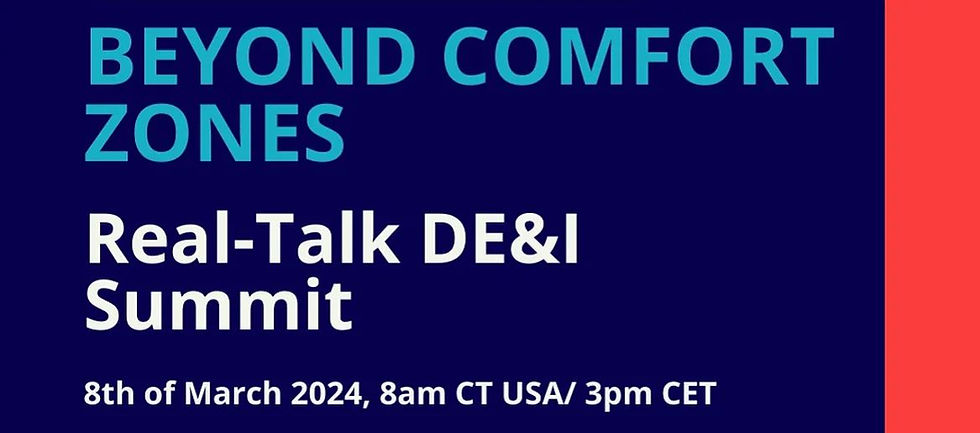Redefining Diversity, Equity, and Inclusion: From Triggering To Transformative
- Allison Davis

- Feb 7, 2024
- 5 min read
Opening LinkedIn on Monday morning, I stumbled upon a post that echoed the ongoing negative discourse around Diversity, Equity, and Inclusion (DE&I).
“Sorry I think all this diversity an inclusion stuff has gone way too far. Everyone is equal, so why are some MORE equal than others!”
“Everyone is equal, so why are some MORE equal than others! And get favoured not on merit but by statistics.”
These were private messages Maureen Frank, another advocate for DE&I, received and shared.
There is such a prevalent anti-DE&I sentiment that's become almost reflexive. I would almost dare to label the terms Diversity, Equity, and Inclusion as trigger words.
And look, I get it. I've delved into contentious discussions myself, addressing Elon Musk's call for the demise of DE&I efforts. I have openly addressed the historical origin of DE&I efforts and how aggressive they once were as they coincided with civil rights movements. I acknowledge that organizations need to adapt outdated approaches in the face of rising legal challenges.
But beyond justifying DE&I's importance, clarity is key.

What exactly do we mean when we talk about Diversity, Equity, and Inclusion?
Basic definitions of diversity miss the point.
Let's start with diversity. Traditional definitions often focus on surface-level demographics such as sex, age, and race.
These characteristics do matter because Governments around the world are still trying to address the impact of the unfortunate historical oppression and consequential bias regarding individuals of specific sex, race, or nationality through civil rights acts, mandatory diversity quotas, or other corrective measures.
Businesses continue to be encouraged by Government policies, investors, and top talents to acknowledge social injustices and increase the diversity within their organization.
As a result, companies take the data stored in their software system such as employees’ age, sex, nationality, seniority in the company, pay grade, language, physical abilities, and other details (depending on the organization and country) and put it into Info-graphics, dashboards and annual diversity reports. Much emphasis and targets are placed on the previously oppressed categories of individuals and the concept of diversity remains at a superficial level.

While these types of metrics provide transparency, help uncover many insights, and track the progress of organizational efforts which have been intended to uproot systemic racism in the workplace; categorization of individuals based on these few attributes is far too limiting.
Diversity goes beyond sex, race, or nationality.
Diversity Defined
Within the Workplace, Harvard has explained diversity using 4 categories:
Internal Diversity: These include characteristics related to situations that a person is born into and are impossible to choose or change. This includes things such as age, national origin, etc.
External Diversity: These include characteristics related to a person which are heavily influenced (or in some cases forced upon) by other people and their environment. Such characteristics can and will likely change over time. This includes appearance, education, family status, personal interests, etc.
Organizational Diversity: This refers to the differences assigned by the organization such as management status, employment status, pay grade, or job function.
Worldview Diversity: This dimension of diversity constantly changes through life experience. It encompasses political beliefs, morals, and outlook on life.
In my book Beyond Comfort Zones The Real-Talk Approach to Diversity, Equity, and Inclusion I provide an exorbitant amount of examples that drive home the fact that the term diversity is just as diverse as what it implies.
However, at Open Heart Inclusion, we define diversity as: the limitless combinations of characteristics that make each individual unique.
Inclusion Defined
Now that we’ve got a better (hopefully less triggering) grasp on the term diversity, let’s define inclusion.
Open Heart Inclusion defines inclusion as the attempt to understand, appreciate, and leverage whenever possible the limitless combinations of characteristics that make each individual unique.

Now that definition sounds phenomenal, I should know because I wrote it. However, it’s important that I address that it’s not going to be humanly possible to get to know, understand, and therefore consider every aspect of every person’s diversity on your team and certainly not within your entire organization.
For obvious reasons, it’s not necessarily common to talk about deeper aspects of one’s background in the workplace such as upbringing or family structures. Some aspects of ourselves are typically frowned upon altogether as topics of discussion in the workplace such as religious or political beliefs. And it’s not every day we consider our own morals; they rather show themselves in our decision making and behaviors. Furthermore, some people may not want to disclose so much about themselves or their background and may have different expectations for how open they want to be in the workplace.
While it may be impossible to fully understand others’ entirety, it’s still crucial to make an effort to better understand and get to know the people you work with. By doing so, you not only build stronger relationships but also are better prepared to recognize and leverage the unique strengths and characteristics of those around you when opportunities arise.
Equity Defined
Now, onto the most contentious term...
I explain this further in another blog, however, equity is often confused with equality.
A somehow understandable mistake, however, the two terms have very different meanings.
Equality implies treating everyone the same and providing equal opportunities to all individuals while equity recognizes that not everyone starts from the same position and thus requires tailored support to achieve a level playing field.
It is crucial to understand that equity is not about favoring certain individuals or providing special treatment. Instead, it confronts the existing disparities and works towards addressing the root causes of inequality through targeted interventions that promote fairness and justice.
Several iterations of this classic image have been used to depict the difference between equity and equality as well as the importance of equity in achieving true fairness and inclusivity.

The term Equity, at Open Heart Inclusion, is defined as offering opportunities that acknowledge and address individual needs without diminishing anyone's worth or potential.
In no way will we ever imply that anyone is less than anyone else, or deserves unfair advantage either.
If you're still struggling with this concept, try thinking about it this way - if a team member needs to work from home due to family responsibilities, accommodating that need isn't about giving them an unfair advantage—it's about enabling them to perform at their best.
Let's Rewrite The Narrative Together
This work matters now more than ever, and Open Heart Inclusion is not just talking about it—we're rewriting the narrative. Join us at the Beyond Comfort Zones, Real-Talk DE&I Summit on March 8th.

Fed up with superficial fixes that don't work anyways? Ready to break through comfort zones and spark genuine transformation? This isn't going to be your run-of-the-mill diversity training. It's a movement towards lasting change and inclusivity in the corporate world.
Expect raw, authentic conversations that cut through the noise and get to the core of how to make DE&I operational and effective. Gain exclusive access to impactful case studies, actionable frameworks, and a copy of "Beyond Comfort Zones: The Real-Talk Approach to Diversity, Equity, and Inclusion."
Don't miss your chance to be part of the solution.
Join us and let's shape the future of DE&I together.





Comments